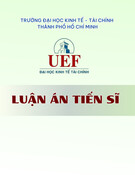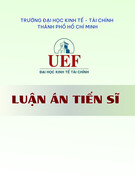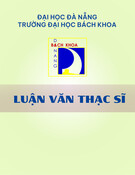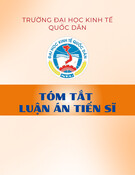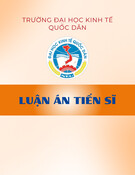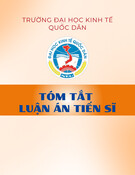1
DEPARTMENT OF EDUCATION AND TRAINING
THAI NGUYEN UNIVERSITY
NGUYEN THI PHUONG HAO
THE IMPACTS OF FLUCTUATIONS OF INPUTS PRICE ON THE ECONOMIC EFFICIENCY OF TEA PRODUCTION OF FARMER HOUSEDOLDS IN THAI NGUYEN PROVINCE
Speciality: Agricultural Economics
Code No.: 62.62.01.15
Ph.D THESIS SUMMARY OF AGRICULTURE THAI NGUYEN, 2014
2
The study was done at:
COLLEGE OF ECONOMICS & BUSINESS ADMINISTRATION, THAI NGUYEN UNIVERSITY
Scientific supervisors: 1. Doan Quang Thieu PhD.
2. Assoc. Prof. Nguyen Dinh Long PhD.
The peer review 1: ..................................... The peer review 2: ..................................... The peer review 3: ..................................... The thesis is prevented to the Council held in Thai Nguyen University at the …, … , 2014 Desertation can be found at:
- National Library
- Learning Resource Center, Thai Nguyen
University
- Library of College of Economics & Business
Administration
3
PREAMBLE
1. The necessity of the subject
labor, fuel
The economic efficiency of tea in Thai Nguyen has given farmers and the province economic benefits. However, in recent years, the input market of tea production has fluctuated, which is detrimental to farmers. Prices of inputs such as fertilizers, plant protection chemicals, stimulants, ... has been continuously increasing, causing difficulties to a majority of farmers and adversely affecting their tea production efficiency. In this context, facing general difficulties of tea sector of Thai Nguyen and of tea farmers in the province, it is very necessary and practical to conduct a study which assesses the impact of price fluctuations of inputs on production, results and efficiency of tea farmer households, therefore introducing practicable solutions to improve the efficiency of tea production. From the above reason, the author has chosen the subject “The impacts of fluctuations of inputs price on the economic efficiency of tea production of households in Thai Nguyen province” as a doctoral dissertation. 2. The research purposes
The purpose of the thesis rearch is to propose a number of measures to advise the government and farmers to behave properly to improve the efficiency of tea production in Thai Nguyen, after analyzing the influence of price fluctuations of inputs on efficiency of tea production of households in the province. 3. Object and scope of the thesis research
* Object: The main researching objects of the thesis research are economic efficiency in tea production of farmer households, the impact of increasing price of inputs on economic efficiency in tea production of farmers, the influence of inputs on productivity and technical efficiency in tea production of farmers in Thai Nguyen province.
* Scope: Of content, the research limits on the economic efficiency in tea production of farmers before and after increasing price of inputs; the influence of increasing price of inputs on economic efficiency in tea
4
through direct
production of farmers; analysis the impact of various types of inputs on the technical efficiency in production of farmers in Thai Nguyen; the impact of rising costs on economic efficiency in tea production of farmers. Of space, the research limits on Thai Nguyen province. Of time, the research uses secondary data collected from 200 to 2012. Primary data was collected interviews with households in 2008, and 2012. 4. The layout of the thesis
Besides the introduction and conclusion, the thesis consists of 04
chapters: Chapter 1: The rationale for the impact of increasing price of inputs on economic efficiency in tea production of farmer households. Chapter 2: Research methodology. Chapter 3: Impact of increasing price of inputs on economic efficiency in tea production of farmer households in Thai Nguyen province. Chapter 4: Major solutions to improve economic efficiency in tea production of farmer households in Thai Nguyen province.
Chapter 1. THE RATIONALE FOR THE IMPACT OF INCREASING PRICE OF INPUTS ON ECONOMIC EFFICIENCY IN TEA PRODUCTION OF HOUSEHOLDS 1.1 Rationale for the price, price fluctuations and economic efficiency in tea production of households 1.1.1 Specification and economic characteristics of tea plant
According to Willson, K.C (1992 ), the scientific name for tea plant is Cmaellia sinesis whose leaves and buds are used to produce tea .There are many factors influencing tea production such as natural conditions ( soil , climate), technical ones( breed, irrigating water, fertilizer, planting density, hewing, picking tea . .. ), economic ones (prices ... ). 1.1.2 Farm household’s economy
There are many different notions of farm household and farm household’s economy. Refering to documents, the dissertation farm presents
households
concept
farm
and
the
of
5
that
is a household
household’economy. Farm household is considered as an economic unit having land, means of production, productive capital owned by the household and mainly using family labor for production in agriculture. The household members are entitled to the income and all decisions are based on the general idea of adult members of the household. Farm household’s economy is kind of economy in which production activitities are based mainly on family labor and its purpose is to meet the demand of the household (not to manufacture goods for sale) . However, it should be noted here that the households can also produce for exchange but at a limited level. 1.1.3 Economic efficiency in tea production of farm households a. The concept of economic efficiency in tea production
Presently there are a lot of views on economic efficiency, but in this topic we refer to some materials and synthesize a concept: Economic efficiency in tea production of farm households is an economic category reflecting the quality of tea production process which is determined by comparing the outputs of tea production with the cost of inputs. b. Factors affecting the economic efficiency in tea production of farm households
Technical factors in tea production (breed, fertilizer, farming practices); Economic conditions and organization of production (production scale , competence of the household head, policy environment) ; social factors (farming practices , ethnicity , gender); price factors (price of inputs, price of tea) ... c. Methods to assess the impact of changes in input prices to economic efficiency in tea production of farm households
Qualitative Analysis : Participatory rural appraisal (PRA) is used, including in-depth interviews, group discussion method, expert meetings, method of scoring and ranking, scheduling, causal diagram (problem tree .. ).
The quantitative analysis is performed by following methods: Comparing the efficiency indicators before and after the price changes. Using the CD production function to assess the impact of price on economic efficiency in the tea production. Using the frontier
6
to analyze
influence of
the
production function inputs on productivity and technical efficiency of tea production. Using creasing regression to analyze the impact of increasing input costs on household economic efficiency. d. Improving economic performance of tea farmers
In order to improve economic efficiency in production, farmers need to consider and follow the directions: Firstly, expanding the scale of production in order to enhance the results obtained, however the growth rate of output must be greater than that of input costs. Secondly, improving the results obtained with unchanged input costs. Thirdly, using inputs economically and effectivelys to reduce production costs while results are constant. 1.1.4 Price and price fluctuation in tea production a. The concept of price and types of price in tea production
Prices in tea production include prices of inputs and outputs. There are many types of prices used in the market depending on the purpose and exchange relationships. In this research for the purpose of considering the effects of increasing price on production efficiency of farmers we mention the following prices: (1) Price of inputs for tea production: comprises costs of materials, services and rental price of labor. (2) Price of outputs of tea production which is the selling price of tea products. b. Price fluctuations and Cause
The concept of price fluctuations is interpreted as the increase or decrease in the price of products on the market from time to time or space. In this research, price fluctuations are subject to increasing price of inputs typically between one or several production cycles that can create the risk of increasing or decreasing perfomance and production efficiency.
The main causes of price fluctuations are: Currency inflation (depending on the macroeconomic policy of the government); External price fluctuations (regional and international prices); Urbanization: Increasing demand, attracting rural labours makes rural labors’cost increase; Events, factors caused reduced demand or increased supply (eg, natural disasters, avian flu , mad cow epidemi);
7
Consumer psychology (eg, fear of disease transmission products ); Monopsony situation , exclusive sales; Other causes .... c. The impact of increasing price of inputs on tea production
Price fluctuation is not a new phenomenon but contains many potential instability of agricultural production. Price risk is the biggest obstacle to the development of farmers which have smal - scale production. Economic cooperation is a solution to help smallholders overcome the "shock" in price and increase production efficiency. 1.2 Practical basis of the impact of increasing price of inputs on economic efficiency in tea production of farmers 1.2.1 Price fluctuation of some key inputs in tea production
Fertilizer is a key input in the production of tea. The price of fertilizer increased greatly recently which had a strong impact on the efficiency in tea production of farmers in Vietnam in general and in Thai Nguyen province in particular. 1.2.2 Lessons of farmers to cope with price fluctuations of input
Lesson 1: State plays an important role in price management, price stability and farmers’support to minimize risks caused by increasing price.
Lesson 2: To expand production and promote access to capital is the best solution to overcome the impact of increasing prices of labor and fertilizer in production.
Lesson 3: Farmer organizations, industry organizations and industry coordination is a solution to overcome the impact of increasing price of inputs. 1.3 Overview of the study
In the past few years there are many studies on tea and farmers in Thai Nguyen province, these works mainly refer to issues about resources of farmers producing tea, there has been no work which researched comprehensively and specifically the impact of price fluctuations on economic efficiency of farmers in Thai Nguyen province. Therefore, the study “The impacts of fluctuations of inputs price on the economic efficiency of tea production of households in
8
Thai Nguyen province” has practical significance, meeting practical requirements.
Chapter 2. RESEARCH METHODOLOGY
2.1 Approach and analytical framework 2.1.1 Approach
The study has used the participatory approach, the area approach, the economic situation of households approach, household type approach, public and private sector approach. 2.1.2 Analytical Framework 2.2 Research Methodology
* Subject: Thai Nguyen province is chosen as the subject of the
thesis.
* Data collection: - Secondary Data Collection: Through books, articles, published
materials, documents available ...
- Primary Data collection: household survey method comprises the following steps: selecting the survey; selecting households; determining the number of households surveyed; surveying households.
* Synthetic Methods: The study uses synthetic tools: Excel,
EViews, Frontier.
* Methods of analysis: Qualitative Methods: Using PRA analysis tools, tree matter,
priority rank.
Quantitative Methods: descriptive statistical method, comparative method, disaggregated approach, modeling methods: Using Cobb - Douglas production function for analysis of price factors affecting economic efficiency in tea production of farmers. Applying frontier function to analyze the impact of inputs on productivity and technical efficiency of households. Using creased regression analysis to analyze the impact of increase in the cost of inputs on economic efficiency of households.
9
Chapter 3. EFFECTS OF INCREASING PRICE OF INPUTS ON ECONOMIC EFFICIENCY IN TEA PRODUCTION OF FARMERS IN THAI NGUYEN PROVINCE 3.1. Natural and socioeconomic features of Thai Nguyen province Based on natural features, Thai Nguyen has the potential to develop tea plant. The province has the 2nd largest tea area in the country (18 605 ha), 9 districts and cities produce tea. Thanks to the blessed soil, water, climate, it suits tea very much. Therefore, raw fresh tea in Thai Nguyen has very high quality. Beside, tea producers in Thai Nguyen have sophisticated care, harvesting and processing techniques which have created the characteristic of Thai Nguyen tea, 100 % of the products are green tea products, high-grade green tea, mainly for domestic consumption and exports. 3.2. Price fluctuations of inputs in tea production 3.2.1 Limiting period of price fluctuations of inputs tea production in recent years to conduct research
Research chooses the landmark of 2007 which was before price fluctuation, in which prices of inputs had not fluctuated much. Research chooses 2011 which was after price fluctuation, in which prices of inputs increased and became stable, interest rate was fixed, inflation was slight and weather did not change much. 3.3.2. Fluctuations in the price of some key inputs in tea production
In recent years, inputs such as fertilizer, plant protection chemicals, fuel, labor ... fluctuated greatly. Causes contributing to the increase in price of inputs in tea production in recent years are: fluctuation in world market prices, urbanization, monetary inflation, consequence of macroeconomic policies, monopoly of agricultural services, profiteering and others ... 3.3 Assessing the impact of fluctuation in price of input on economic efficiency in tea production of farmers in Thai Nguyen province 3.3.1. The situation of tea production of researched households
- Types of households: Tea production of households seemed to increase after price fluctuation. Prices of inputs in the production of
10
income’s
tea grew which made the price of tea products increase, thus tea production of households are reflected through norms of production increase after value’s, added value’s and mixed fluctuations in price of inputs .
Value of tea production of specialized households increased more greatly than non-specialized households. After fluctuations in price of inputs, specialized households got the value of tea production of 52 577 ngd, non-specialized got 40 441. Considering mixed income, specializing households still had higher growth rate than non- specialized ones. Comparing the tiem after price fluctuations with the time before price fluctuations, the growth rate of mixed income of specialized households was 72%, of non-specialized ones was only 61%.
tea production of researched
in
- Level of income: Production value of wealthy households at the time before price fluctuations of inputs was 1.69 times greater than average households and 3.87 times greater than poor ones. Mixed income of wealthy households is 1.44 times higher than the average household and 4.05 times greater than the poor ones. After price fluctuation, the gap between wealthy households and average and poor ones is widening. The production value of wealthy households is 2.2244 times and 5.18 times higher than that of average household and of poor household, respectively. Mixed income of wealthy households is 2,03 times and 5.45 times higher than that of the average household and of the poor one. After price fluctuations, wealthy households’production value increased from 32604 ngd to 76864 ngd, income increased from 21921 ngd to 42088 ngd. Indicators of tea production of poor households increased but less than wealthier households, production value increased from 8422 ngd to 14830 ngd.. Mixed income of poor households increased from 5411 ngd to 7718 ngd. The average household’s production value and mixed income also increased after price fluctuations. 3.3.2 Economic efficiency households
* By types of household: Table 3.16 shows the efficiency of using captial of two groups changes differently, overall efficiency of the two groups decreased after price fluctuations. On average, before price fluctuation, cost of 2.654 thousand dong resulted in production
11
value of 3,747 thousand dong and mixed income of 2,654 thousand dong. After fluctuation, costt of 1 thousand dong resulted in production value of 2,749 thousand dong and mixed income of 1,624 thousand dong. Labour efficiency of household also decreased after price fluctuation. On average, before price fluctuation, labour cost of 1 thousand dong resulted in production value of 3,158 thousand dong and mixed income of 2,232 thousand. Labor cost increased which reduced labor efficiency. After fluctuation, labour cost of 1 thousand dong resulted in production value of 2,757 thousand dong and mixed income of 1,522 thousand dong.
Table 3.14. Economic efficiency in tea production of different types of household (on average)
Indicator unit Average Specialized household Type of production Non- specialized household
Ngđ/rod Ngđ/rod Turn Turn Turn Turn 2,991 2,162 3,792 2,741 2,920 2,111 3,67 2,53 3,690 2,544 3,462 2,387 3,289 2,323 3,747 2,654 3,158 2,232
Before fluctuation 1. GO/DT 2. MI/ DT 3. GO/IC 4. MI/IC 5. GO/LĐ 6. MI/LĐ After fluctuation 1. GO/DT 2. MI/ DT 3. GO/IC 4. MI/IC 5. GO/LĐ 6. MI/LĐ Ngđ/rod Ngđ/rod Turn Turn Turn Turn 6,047 3,719 2,941 1,808 2,564 1,577 7,382 4,097 2,506 1,391 2,617 1,453 6,634 3,885 2,749 1,624 2,587 1,522 Source: Summary of household survey data in 2012
to increase more greatly,
tend
* By income There are also significant disparities in efficiency between wealthy households with average and poor ones. GO, VA, MI of wealthy households therefore production efficiency was higher than that of poor households.
12
Average households have the highest efficiency. Considering the impact of price fluctuations, the efficiency in using land of households increased. But efficiency in using capital and labor decreased.
Table 3.15. Efficiency in tea production of households by income (average/household)
Average
Indicator
Unit
Wealthy household
Average household
Poor household
Before fluctuation
1. GO/DT Ngđ/rod 3,385 3,018 2,955 3,103
2. MI/ DT Ngđ/rod 2,276 2,380 1,898 2,220
3. GO/IC Turn 3,351 5,371 2,978 4,159
4. MI/IC Turn 2,253 4,236 1,914 3,053
6. GO/LĐ Turn 3,448 3,275 1,985 2,975
6. MI/LĐ Turn 2,318 2,583 1,276 2,155
After fluctuation
1. GO/DT Ngđ/rod 7,980 5,415 5,203 6,075
2. MI/ DT Ngđ/rod 4,370 3,251 2,708 3,417
3. GO/IC Turn 2,508 2,785 2,294 2,574
4. MI/IC Turn 1,373 1,672 1,194 1,459
6. GO/LĐ Turn 3,111 2,309 1,404 2,289
6. MI/LĐ Turn 1,704 1,386 0,731 1,298
Source: Summary of household survey data in 2012 Before price fluctuation, cost of 1 thousand dong resulted in mixed income of 2,253 thousand dong in wealthy household, of 4,236 thousand dong in average household and 1,914 thousand dong in poor household. After price fluctuation, cost of 1 thousand dong resulted in mixed income of 1,373 thousand dong in wealthy household, of 1,672 thousand dong in average household and 1,184 thousand dong in poor. Labour efficiency of poor household after
13
price fluctuation was very low. This proved that increasing price of labor greatly affected poor household. 3.3.3 Analysis of the impact of increasing price of inputs on efficiency in tea production of farmers 3.3.3.1 Analysis of price factors affecting economic efficiency in tea production of household The thesis used Cobb - Douglas production function to analyze the impact of increasing price on economic efficiency of production of tea farmers. Price factors affecting economic efficiency in tea production of farmers include: selling price of tea bud’s products, price of inputs (fertilizer, pesticide, fuel, labor), household type, education level of household head, gender of household head and production technology of household. * Analysis of prices affecting MI /rod Production function:
Using EViews software to estimate the results obtained:
Y = 35,547.
Coefficient αi is (+) positive, suggesting that the selling price of tea increased which made mixed income/rod increased. Specifically, when other factors unchange, if the price of tea increased by 1 %, mixed income/rod would increase by 0.219 %, meaning that when product prices increase by 1 thousand dong, mixed income/rod increases by 0.731 thousands dong.
Coefficients α1, α2, α3, α4, α5 are (-) negative, suggesting that when price of inputs (fertilizer, pesticide, fuel, herbicide, outsourced labor) increases, mixed income / rod decreased.
Specifically, the biggest deciding factor to economic efficiency in the production of tea of household is the price of fertilizer. When fertilizer price increased by 1 %, mixed income of households/rod fell by 0.322 %. Provided that other factors are constant, the price of fertilizer increased by 1 thousand dong then mixed income/rod decreased by 4.404 thousand. In case fertilizer prices increased so greatly, households must invest fertilizer according to technincal
14
instructions as well as fertilizer limit for tea plants with the lowest cost to achieve the highest economic efficiency. Cost of outsourced labor had a major influence on mixed income/rod of household. When outsourced labor cost increased by 1 %, mixed income/rod decreased by 0.195 %. When price of pesticides increased by 1 % , mixed income of households/rod fell by 0.095 % , meaning that when price of pesticides increases by 1 thousand dong, mixed income of household decreases by 1.572 thousand. Effect of pesticides is to limit pest, stimulating tea and higher tea production. However, pesticides and drugs should be used moderately and appropriately to ensure the quality of tea and save costs.
The dummy variable for the type of tea growers showed non- specialized households have lower mixed income / rod than specialized ones by 0,273%. This is because specialized households know how to invest in tea production more reasonably than non- specialized ones. Dummy variable for manufacturing technology shows households applying innovative machine have lower mixed income / rod than non-specialized ones by 0.189 %. The reason is that households applying innovative machine invest more on fuel for production whose price increases causing their cost increase and reducing their mixed income/rod. - Analysis of price factors affecting the efficiency costs (MI/IC)
Estimation resulted in results:
Y= 20,794.
The biggest determining factor to their cost effectiveness is the price of outsourced labor. When the price of outsourced labor increases by 1%, the MI / IC of household decreases by 0.757 %. When fertilizer prices increases by 1 %, the MI / IC 0.064 % of households decreased . As fuel price rises by 1 %, mixed income of households / cost decreased by 0,084 %. Pesticide price increased by 1 % then the MI / IC decreased by 0.080 %. The dummy variable for the type of tea growers shows that non-specialized households’ MI / IC is 0.273% lower than specialized ones.
15
3.3.3.2 Analysis of the influence of inputs on productivity and technical efficiency in the production of tea of households
The thesis use the limited production function to analyze the impact of various types of inputs on productivity and technical efficiency in tea production. Effectiveness of using production costs and technical efficiency of farmers are reflected in the results estimated from Cobb - Douglas production function (OLS - Average function and MLE - Frontier function).
Variable
Table 3.18. The results estimated from the limited production function OLS (Average function) MLE (Frontier function) Coefficient 3,814 Coefficient 3,816 t- test 6,762 t- test 5,315
0,059 1,591ns 0,042 1,415
0,083 0,0103 1,562ns 6,363 0,074 0,0104 1,353 9,230
0,043 0,028 0,057 3,182 2,181 3,843 0,045 0,029 0,057 5,579 2,806 3,872
0,064 2,682 0,065 2,706
Coefficient of freedom The amount of urea Phosphorus Amount of potassium Amount of NPK Pesticide Amount of manure Amount of working day Sigma-square: 0.149766 Gamma: 0.850231 Sigma-square: 0.129173 Gamma: 0.870826
Note: ns: No statistically significant The estimated results in Table 3.20 show inputs such as potash, NPK fertilizer, pesticides, manure and care help increase the productivity of farmers producing tea in Thai Nguyen.
Ptassium being increased by 1 % would make tea leaves yield increase by 0.01 %. That is, potassium being increased by 1kg / rod would cause yield increase by 0.69 kg/rod. Similarly, NPK being increased by 1% would cause tea yield increase from 0.043 % to 0.045 %, meaning that potassium being increased by 1kg / rod would cause yield increase by 1.76 kg/rod.
Manure being increased by 1 % would make tea yield increase by 0.057%, that is manure being increased by 1kg/rod would casue tea
16
yield increase by 1.8 kg /rod. Likewise, working days being increased by 1 % would make tea yield increase by 0.064 - 0.065 %. Coefficient of nitrogen and phosphate fertilizer are not statistically significant, which may be explained that investment of these factors was so high that their impact on tea yield was low and unclear.
Table 3.1. The effect of tea production techniques surveyed households Level of technical efficiency Ratio (%) Number of households < 60 % 0 0
60 – 70 % 42 11,69 70 – 80 % 71 26,79 80 – 90 % 105 39,62 90 – 95 % 36 17,35 95- 100 % 11 4,55 Average technical efficiency 80,68 %
Source: Result from running the Frontier function From the results estimating the model, the technical efficiency of farmers in Thai Nguyen is determined. Table 3:21 shows that the average technical efficiency of tea producers in Thai Nguyen reached 80.68 % compared with the potential yield which can be achieved in normal farming conditions. Thus, Thai Nguyen province is still likely to increase the yield more tea if inputs like potash NPK, manure and labor are invested more along with improving cultivation techniques of farmers.
In short, models show that inputs like NPK, potassium, manure, pesticides, labor play an important role enhancing productivity and technical efficiency in tea production of farmers in the province. 3.3.3.3 Effect of cost fluctuation on economic efficiency To assess the impact of fluctuations in costs on the economic efficiency of households, the thesis used the creased regression models to analyze. Regression takes the form:
E (Yt) = a1 + a2.Xt + a3.(Xt - Xt0).Dt + Vt
Where: Yt is mixed income (MI ) of households ;
Xt is the intermediate costs of households in 2011;
17
Xt0 the intermediate costs of households in 2007;
Results of regression analysis obtained regression of the form: Xt Yt = 18 547 + 2,504 - 1,045.(Xt - Xt0 ) Dt
Comparing effectiveness of using capital before and after fluctuations shows that the coefficient a3 = -1.045 < 0 indicating effectiveness of using capital after fluctuation was lower than that before fluctuation by -1.045 units .
MI = 24109 + 1,009 IC
MI = 18547 + 2,504 IC
Chart 3.5. Effectiveness of using costs before and after price fluctuation
- Before fluctuation (D = 0): MI = 18 547 + 2,504 IC Thus, before fluctuations, every extra 1 thousan dong of capital will increase the effectiveness of investment by 2.504 thousand dong of mixed income. - After fluctuation (D = 1): MI = 24109.535 + 1.009 IC Thus, after fluctuation, every extra 1thousand dong of cost will increase the effectiveness of investment income by 1.009 thousand of mixed income. 3.3.4 General comments on the impact of increasing price of inputs on economic efficiency in tea production of households
18
* Comparing the growth of increasing tea production with the growth of increasing tea production cost of households
Table 3.22 . Growth and cost outcomes by type of household Unit: ngd
Before fluctuation
After fluctuation
Growth rate (%)
Indica -tor
Specialized household
Specialized household
GO 25.988
Nonspecializ ed household 12.455
52.557
Nonspecializ ed household 25.025
Specialized household 102
Nonspecializ ed household 101
VA 19.135 9.080 33.686 15.042 76 66
MI 18.789 8.587 32.324 13.889 72 62 TC 7.199 3.868 20.233 11.136 181 188 IC 196 3.375 6.853 9.983 161
Indic -ator
Poor
Poor
Poor
GO VA MI TC IC
17.871 (Source: Summary of household survey data in 2012) Table 3.23. Growth rate of results and and cost by income Unit: ngd
Before fluctuation Ave- Weal rage -thy 19.3 32.6 15.7 22.9 15.2 21.9 4.1 10.7 3.6 9.7
8.4 5.6 5.4 3.1 2.8
After fluctuation Aver age 34.6 22.1 20.7 13.8 12.4
Wea-- thy 76.9 46.2 42.1 34.8 30.6
14.8 8.4 7.7 7.1 6.5
Growth rate (%) Aver -age 79 41 37 239 246
Wealt -hy 136 102 92 225 215
76 59 43 136 129
(Source: Summary of household survey data in 2012)
The impact of the rise in prices of inputs in the production of farmers exacerbated their costs. Along with rising costs, price of tea products also increased, production value and household’s income also increased. However, the growth rate of costs was greater than that of the results. This reduced the economic efficiency in tea production of farmers. Specifically, for non-specialized households, the growth rate of mixed income is 72 % but the growth rate of the total cost and intermediate costs were respectively 181 % and 161 %, 2 times more than the growth rate of results. Non-specialized households were affected as specialized ones. The growth rate of costs of non-specialized household were greater than that of specialized ones. In terms of income, average household and wealthy household had greater growth rate because they remain high level investment for tea
19
production. Poor households lacked the resources, therefore when price of inputs increased, they cut down on costs for production which reduce the growth rate of costs. After fluctuation, the growth rate of mixed income of wealthy and average households were 92 % and 37 %, respectively. While the growth rate of intermediate costs of wealthy and average households were 215 % and 246 %, respectively. * Evaluation of economic efficiency in tea production of household after iincreasing price of inputs
Table 3.24. Comparing the efficiency in tea production of household before and after increasing price of inputs (by types of household)
Indicator Specialized households Relative Absolute (%) (times) Non-specialized households Relative (%) Absolute (times)
1. GO/DT 2. VA/DT 3. MI/ DT 4. GO/IC 5. VA/IC 6. MI/IC 7. GO/LĐ 3,056 1,674 1,447 - 851 - 907 - 933 - 356 202,2 176 172 77,6 67,5 66 87,8 3,712 1,767 2,440 -1,184 - 1,184 - 1,153 - 845 201,1 166,2 196,4 67,9 56,0 54,7 75,6 8. VA/ LĐ - 506 6,5 - 951 62,3 9. MI/LĐ - 534 74,7 - 934 60,9 (Source: Summary of household survey data in 2012)
20
Table 3.25. The efficiency in tea production of household before and after increasing price of inputs (by income)
Wealthy household Poor household Average household Indicator
Absolute (times)
Relative (%) 235,7
Absolut e (times) 2.379
Relative (%) 179,4
Absolut e (times) 2.248
Relative (%) 176,1
1. GO/DT 4.595 202,1 1.015 141,3 974 149,6 2. VA/DT 2.424 192,0 871 136,6 810 142,7 3. MI/ DT 2.094
74,8 - 2.586 51,9 - 684 77,0 4. GO/IC - 843 64,1 - 2.586 40,8 -684 65,4 5. VA/IC - 843 60,9 - 2.564 39,5 - 720 62,4 6. MI/IC - 880 90,2 - 966 70,5 - 581 70,7 7. GO/LĐ - 337 77,3 - 1.185 55,5 - 1.380 0,1 8. VA/ LĐ - 549 73,5 - 1.197 53,7 - 1.275 0,1 9. MI/LĐ - 614
labor efficiency, speed
(Source: Summary of household survey data in 2012) Considering the pace of development of land use indicators in table 3.24 and 3.25 shows that they are greater than 100 % reflecting the increasing efficiency after price fluctuation. In terms of cost the development of efficiency and performance indicators are less than < 100 % indicates cost efficiency and reduced labor efficiency.





![Luận văn Thạc sĩ: Tổng hợp và đánh giá hoạt tính chống ung thư của hợp phần lai tetrahydro-beta-carboline và imidazo[1,5-a]pyridine](https://cdn.tailieu.vn/images/document/thumbnail/2025/20250816/vijiraiya/135x160/26811755333398.jpg)









